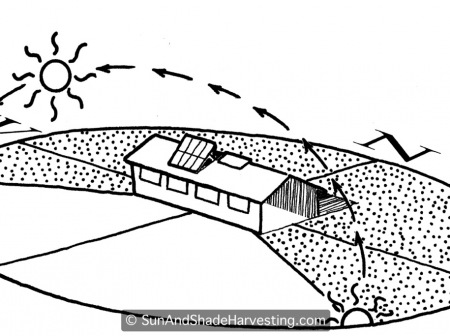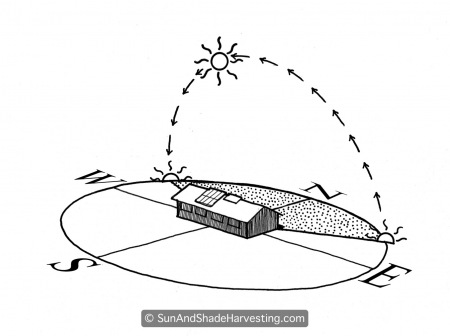Dance with—and Harvest—the Sun and Shadows! New Videos Show You How
by Brad Lancaster © 2013
www.HarvestingRainwater.com
www.SunAndShadeHarvesting.com
I heat, light, and power my home primarily with the sun, and cool it primarily with shadows and natural ventilation. Free/passive strategies are at the core of how I make all this work. Examples include choosing a home oriented to the sun, likewise orienting my landscape to the sun, allowing the maximum amount of sun to enter my windows in winter, and maximizing cooling shade in summer.
This saves a lot of money and water. Water is saved because I use less power, the generation of which—if pulled from the utility grid—typically occurs at water consumptive thermoelectric power plants. (I save still more water by generating on-site power during the day via rooftop solar panels).
You can do likewise. The first step is to see and understand how the path of the sun and resulting shadows change with each season and at different latitudes. Then you dance or work with those flows.
The seasonally changing path of the sun illustrated above is fairly similar for all latitudes beyond 24º (Tropic of Cancer and Capricorn), but for more exact sun paths, angles, and strategies for all latitudes, see my book Rainwater Harvesting for Drylands and Beyond, Volume 1, 3rd Edition. The following builds on the info in the book.
The videos below illustrate how we can work with these seasonally changing sun paths.
• Free Harvest of Winter Sun & Heating: Winter-Solstice Paths of Sun & Shadow on Home with a Solar Arc of Trees and Shrubs
See how this ideal orientation of home and landscape to the sun—plus appropriately sized equator-facing roof overhang—maximizes the on-site potential to freely/passively harvest warming sun and light in winter, generate rooftop-solar power year round, and harvest cooling shade in summer. Compare this to the summer video below…
• Free Harvest of Summer Shade & Cooling: Summer-Solstice Paths of Sun & Shadow on Home with a Solar Arc of Trees and Shrubs
See how this ideal orientation of home and landscape to the sun—plus appropriately sized equator-facing roof overhang—maximizes the on-site potential to freely/passively harvest cooling shade in summer, generate rooftop-solar power year round, and maintain ideal solar access in winter.
• Sun- & Shade-Harvesting Awning and Roof Overhang
— Simple strategy working with the 20ºF (11ºC) or greater difference between spring and fall equinox temperatures
• Winter Solstice Sun and Shadow Paths—Micro Version
— Highlights how to maintain winter access to the sun by properly placing and spacing trees and structures in relationship to equator-/winter sun-facing walls and windows
• Winter Solstice Sun and Shadow Paths—Macro Version
— Shows the sun’s location and path in the sky on the winter solstice
See www.SunAndShadeHarvesting.com for still more on-line Sun- & Shade-Harvesting strategies, images, and resources.
See the new, full-color, revised editions of Brad’s award-winning books
– available a deep discount, direct from Brad:

Volume 1
Volume 1 has detailed sun & shade harvesting info on:
- Orienting buildings and landscapes to the sun
- Designing roof overhangs and awnings to optimize winter sun and summer shade
- How to choose and size windows to optimize passive heating and cooling
- Solar arcs
- Sun & shade traps
- Maintaining winter sun access with winter-solstice shadow ratios and solar rights
- Sun angles and path for any latitude and season
- How to find your way, and true north or south, with the sun and other stars
- How to place vegetation or structures to maximize natural ventilation or windbreaks
- Table comparing the energy consumed, water consumed, and carbon emitted of active and passive clothes drying, water heating, food storage & prep, lighting, heating, and cooling strategies.



